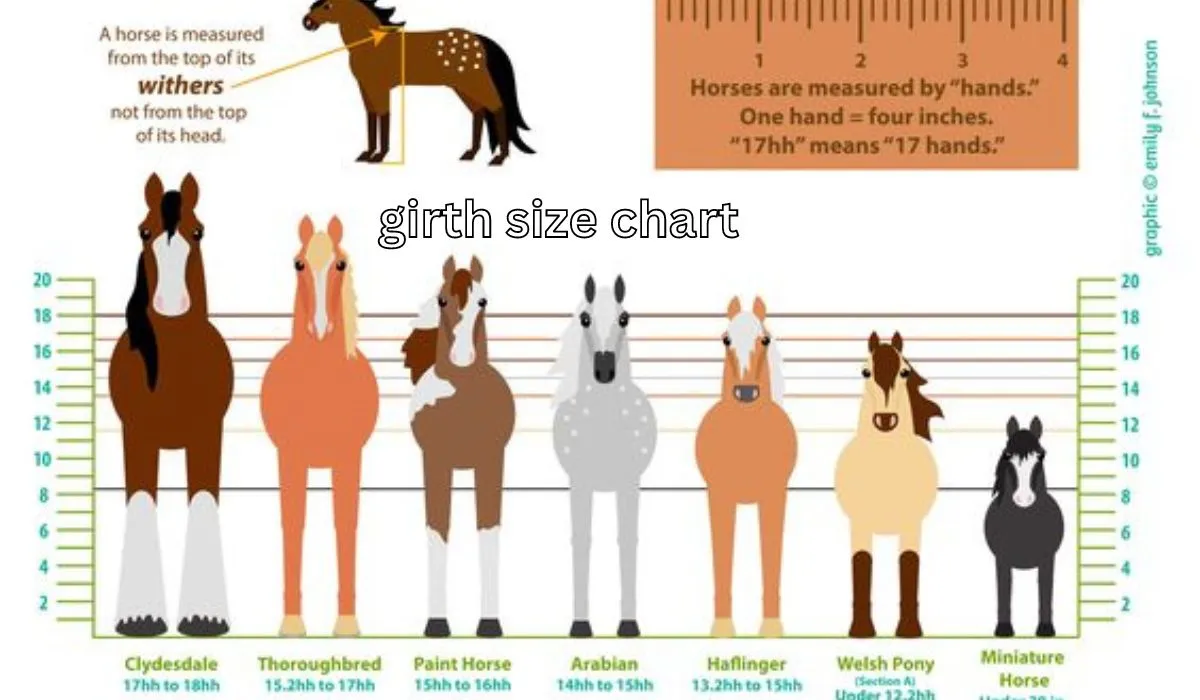When it comes to selecting the right girth for your horse or other equipment, getting the measurements just right is crucial. An ill-fitting girth can lead to discomfort and even health issues for your horse. Understanding and using a girth size chart effectively ensures that you make the best choice. In this comprehensive guide, we’ll walk you through everything you need to know about girth size charts, including how to measure accurately, interpret sizes, and choose the right girth for various purposes.
What is a Girth?
Before diving into girth size charts, it’s essential to understand what a girth is and its purpose. In equestrian terms, a girth is a strap used to secure the saddle on a horse’s back. It runs from one side of the saddle, under the horse’s belly, to the other side. The girth keeps the saddle in place, preventing it from sliding or shifting during riding.
Trending: Understanding CM 53 : A Detailed Exploration
Why is Accurate Girth Sizing Important?
Accurate girth sizing is critical for several reasons:
- Comfort: A well-fitted girth ensures that the saddle stays in place comfortably without pinching or causing discomfort.
- Performance: A properly sized girth enhances the horse’s performance by providing stability and balance.
- Safety: An ill-fitting girth can lead to accidents or injuries. It’s crucial for the safety of both the rider and the horse.
How to Measure Your Girth Size
Measuring for a girth involves a few straightforward steps. Follow this guide to ensure you get accurate measurements:
Step 1: Gather Your Tools
You’ll need a flexible measuring tape or a piece of string and a ruler. It’s also helpful to have someone assist you in taking measurements.
Step 2: Measure the Horse
- Place the Saddle: Position the saddle on the horse’s back as you would for riding. Make sure it’s centered and in the correct position.
- Locate the Girth Points: Identify the girth points on the saddle, which are the spots where the girth will attach. These are usually located just behind the horse’s elbows.
- Measure the Distance: Use the measuring tape to measure the distance between the girth points. This is the length of the girth you will need.
Step 3: Adjust for Fit
To ensure the girth fits comfortably, consider the following adjustments:
- Add a Little Extra: It’s often beneficial to add a bit of extra length to account for the horse’s natural movement and the thickness of any padding.
- Check for Adjustability: Some girths are adjustable, allowing for fine-tuning after initial fitting.
Girth Size Chart: Understanding the Measurements
A girth size chart helps you translate your measurements into standard girth sizes. Here’s how to read and use a girth size chart effectively:
Girth Size Chart Example
| Girth Length (inches) | Girth Length (cm) | Common Use |
|---|---|---|
| 24 | 61 | Miniature Horse |
| 26 | 66 | Pony |
| 28 | 71 | Small Horse |
| 30 | 76 | Medium Horse |
| 32 | 81 | Large Horse |
| 34 | 86 | Draft Horse |
Interpreting the Chart
- Measure in Inches or Centimeters: Depending on your preference, use the girth size chart in either inches or centimeters.
- Select the Appropriate Size: Match your measurement with the closest size on the chart. If your measurement falls between two sizes, choose the larger size for better comfort.
- Consider the Horse’s Build: Different horses have different builds. A larger horse may require a longer girth, while a smaller horse or pony will need a shorter one.
Types of Girths and Their Sizes
Different types of girths are designed for various purposes, and each type may have specific sizing requirements:
1. Dressage Girths
Dressage girths are typically longer to accommodate the saddle’s design and provide a comfortable fit. They often feature additional padding for extra comfort.
2. Jumping Girths
Jumping girths are usually shorter and designed for more flexibility, allowing for greater movement during jumps. They often include additional features like elastic sections.
3. All-Purpose Girths
All-purpose girths are versatile and suitable for various riding disciplines. They come in a range of sizes and styles to accommodate different needs.
Common Mistakes to Avoid When Choosing a Girth
Selecting the right girth involves more than just measuring accurately. Avoid these common mistakes to ensure you get the perfect fit:
1. Ignoring the Horse’s Shape
Every horse has a unique shape and build. Avoid choosing a girth based solely on standard measurements. Consider the horse’s shape and how the girth will fit around its belly.
2. Choosing Based on Saddle Size Alone
The girth should be chosen based on the horse’s measurements, not just the saddle size. Even if the saddle is the correct size, an ill-fitting girth can cause problems.
3. Overlooking Girth Material
The material of the girth affects both comfort and durability. Ensure you choose a material that suits your horse’s needs and is appropriate for the riding discipline.
How to Adjust a Girth for Optimal Fit
Proper girth adjustment is essential for comfort and performance. Follow these steps to adjust your girth effectively:
- Check the Girth Length: Ensure the girth is not too tight or too loose. There should be enough room to fit two fingers between the girth and the horse’s skin.
- Adjust the Buckles: Most girths have adjustable buckles. Use these to fine-tune the fit and ensure the girth is securely fastened without causing discomfort.
- Monitor the Fit Regularly: As your horse’s condition changes, you may need to adjust the girth regularly.
Maintenance and Care for Your Girth
Proper maintenance extends the life of your girth and ensures it remains in good condition. Here’s how to care for your girth:
- Clean Regularly: Clean the girth after each use to remove dirt and sweat. Use appropriate cleaning products for the material.
- Inspect for Wear: Regularly check for signs of wear and tear. Replace any damaged parts promptly.
- Store Properly: Store the girth in a dry, cool place to prevent damage from moisture or extreme temperatures.
Conclusion
Finding the perfect girth for your horse involves more than just picking a size from a chart. It requires accurate measurement, careful consideration of your horse’s needs, and proper adjustment and maintenance. By using the girth size chart effectively and following the guidelines provided in this article, you can ensure a comfortable fit that enhances both performance and safety. Whether you’re a seasoned rider or a beginner, understanding girth sizing is essential for a successful and enjoyable riding experience.
FAQs
1. How often should I measure my horse for a new girth?
It’s a good idea to measure your horse whenever you get a new saddle or if you notice any changes in your horse’s build or weight.
2. Can I use a girth size chart for different types of girths?
Yes, girth size charts generally apply to various types of girths, but always check the specific recommendations for each type.
3. What should I do if my girth doesn’t fit properly?
If your girth doesn’t fit correctly, try adjusting it or consult a professional for advice on choosing the right size.
4. Are there any girth fitting tools available?
Yes, there are various tools and guides available to assist with girth fitting. Consult with your local tack shop or equestrian specialist for recommendations.
5. How do I know if a girth is too tight or too loose?
A girth is too tight if you cannot fit two fingers between the girth and the horse’s skin. It’s too loose if the saddle shifts or moves during riding.
This guide to the girth size chart will help you navigate the complexities of girth sizing, ensuring that you make informed decisions for your horse’s comfort and performance.




